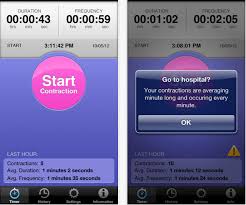
Contraction timers and apps have been around a while. But recently, they've come to feel like a prerequisite. I understand how they have come to seem like a useful tool, an enabling choice – especially in an era when women feel largely unsupported and alone when labour begins. But I'm counselling caution.
People may imagine it's a harmless way to manage and pace themselves through labour, but it's no coincidence that every time I hear about a really long, drawn-out birth, there'll have also been a tonne of timing going on - and it doesn't take much analysis to work out why the two are often connected.
Timing contractions. Watching and waiting for them to increase. This is about as helpful as someone coming into your bedroom in the middle of the night and regularly updating you on how deep you are sleeping. Akin to trying to sneeze or a partner 'waiting' for you to have an orgasm.
Apps and timers engage thinking. Stimulate awareness. They turn birth into a performance sport, with all the labour-inhibiting adrenalin and self-watchfulnesss that goes with that.
'Don't put yourself on a stage' is a tip I offer that many say kept their births simple. And you can see how contraction timers do exactly that.
Watching and waiting for things to build is a very different thing to following and feeling things as they build......the former distances you from your body, the latter connects you. Monitoring oneself to the max might seem like a way to manage and gauge progress. But it easily makes the early stages of birth - when the body is simply preparing - fraught and frustrating. Exhausting too.
So what DO we do? This is what mothers often say, especially when hospitals ask that you call in and tell them how frequently your contractions are coming – when maternity care itself seems to use contraction frequency as the main measure of labour.
Here’s what you do: find out what it is you are waiting for. Talk to other mothers, ask a midwife with a lot of experience. Read about the FIRST ROOM and the SECOND ROOM in Tell Me a Good Birth Story’s book How to Have a Baby.
What you will learn is this. That birth doesn’t increase in strength, in one single smooth, ever-strengthening trajectory. Yes there are crampy waves, and even strong contractions – but these are the wheels on the car, the method of propulsion. Labour itself, the part when the contractions actually start propelling the baby down and through the pelvis, this is something else and as a feeling, you can't miss it or its momentum.
Up until that point comes, it's best to ignore the crampy waves. Before long, you won’t be able to ignore them and will start to breathe through, even close your eyes. But if inbetween you happily bob up and engage with what's around you, this is still early labour. As such, get on with your day (or night) as normally as you can and as the feelings intensity, which of course they will relax. Let go of every muscle in your body once the wave has gone, and rest. Lean, lie, swing, sway - whatever feels good. Distract yourself or simply find comfort lying in a bath, cuddling a hot water bottle, listening to something nice on the radio or leaning forward on your sofa and read a book.
Eventually you will feel a great big shift. A marked change in gear. Now there is nothing at all you can do OTHER than concentrate. Your body is firing on all cylinders; your breathing is utterly focused; and now when you move or take a position, it's because you can't help yourself. It's like you're on automatic..
It’s true that contractions will now be coming very regularly and very rhythmically – every two to three minutes, and by all means tell the hospital so. But what on earth is the point in measuring every little increment up until this point? All you need to feel and all a birth partner needs to see is contractions being consistently intense and powerful.
When it's 1000% consuming like that, you are in labour. THAT is the point when the body has taken over. So what in heaven's name is the point of timing and measuring every little increment of change up to that point? In the process wearing courage, confidence and energy thin
